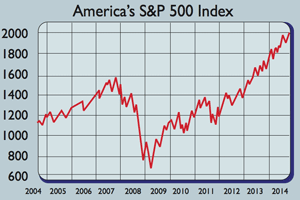
America’s S&P 500 index set a new record above the 2,000 mark this week. The index – which tends to set the tone for the rest of the world’s stock markets – has tripled since the market rally began in March 2009. Solid US economic data and surprisingly good profit growth are behind the latest advance.
What the commentators said
When the S&P hit 1,000 in 1998, “the excitement was palpable”, said Nicole Bullock and Michael Mackenzie in the Financial Times. This time round there is “an undercurrent of uncertainty”.
Valuations have reached historic highs. The cyclically adjusted price/earnings ratio (Cape) is 26, around 40% higher than its historical average. Only in 2000 and 2007 was it higher. Profits look stretched too, said Martin Hutchinson on Breakingviews.
Profits were worth 10.8% of US GDP in the year to March, far above the 60-year average of 7.2%. Globalisation and outsourcing may have given profits a long-term boost, but “cheap debt also plays a part and won’t last forever”.
The tightening labour market will also hit profit margins as wages are pushed higher. Meanwhile, sales growth has been weak during the economic recovery.
There’s also the threat of higher interest rates. Stocks generally shrug off the prospect of dearer money after some initial jitters, as investors see rate hikes as being down to a strengthening economy.
In the last seven major tightening cycles, the S&P rose by an average of almost 5% in the six months before the first hike, noted Capital Economics. Then again, the debt load in developed economies is unprecedented and central bankers are not known for timing rate hikes well.
The rally may well continue for now, but as Oliver Pursche of Gary Goldberg Financial Services put it, investors shouldn’t “look at this as the beginning of the next supercycle”.